Tiger orchid: description and care

Orchid is one of the most delicate and beautiful flowers, so its popularity has gained an unprecedented scale. There are many species of this exotic plant that came to us from the tropics. Many collections of florists are decorated with a tiger orchid. You can find a description of this type, as well as the nuances of planting and care in the article.



Peculiarities
Having appeared in South America, the orchid quickly moved beyond its borders, its breeding became available in different countries. A large number of varieties allows you to choose any flowers. The tiger orchid alone has more than three hundred subspecies. Flowers of this group can be of any color, but a characteristic feature of each subspecies is the presence of a pattern.
It is tiger orchids that are considered one of the most beautiful. The leaves of such plants are long, with brown blotches on the inside. Tiger orchid can be purple, white, yellow, red, but in any color, a characteristic feature will be an addition in the form of specks or stripes... On a yellow background, there may be red spots, on a lilac - purple, on a white - pink. Blotches can have a variety of outlines: large circles, small dots, thin lines, wide stripes. Each flower, regardless of the pattern, looks very beautiful.
With proper care and good climatic conditions, the orchid blooms three times a year.... Every time during the month, she pleases with her graceful flowers. It is worth noting that flowering occurs only in adult plants.
The fact that the plant is adult is indicated by the number of shoots - there should be at least five of them. For the first time, a tiger orchid blooms at the age of one and a half to three years.


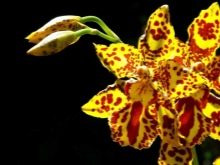
Planting and leaving
A flower grower who has decided to decorate his home with orchids must understand that this is a very delicate plant that requires special care rules.
- The orchid loves the sun, so it should be placed on the south side.... The sun's rays have a beneficial effect on the flowering and beauty of the buds that appear.
- Do not overdo it while ensuring adequate watering. Twice a week is sufficient for the summer months; in winter, watering should be reduced to once. in Week.
- The flower also needs moisture, therefore summer regular spraying will do him good, but in winter the orchid does not need them.
- The orchid will be more comfortable in a transparent plastic pot, such conditions are most favorable for the roots. They need the sun's rays for the plant to develop properly.
- Preferred daytime temperature - from 22 to 25 degrees, at night - from 18 to 20 degrees... To create a cooler atmosphere at night, you can ventilate the room or turn on the air conditioner. In this case, a strong increase or decrease in temperature can have a detrimental effect on the flower. A thirty-degree heat is contraindicated for a plant, as is cold air (at 15 degrees of heat and below).
- Especially you need to carefully approach the choice of soil... There are two options - to purchase a special substrate in the store or prepare it yourself, collecting all the components. This requires moss, pine bark, fern roots, peat, sand, walnut shells, charcoal. Such a composition will be ideal for growing an orchid. Pine moss and bark can be harvested in springtime. Both are easy to find at the foot of the trees. Regular nutrient soil will never work... It is too heavy for an orchid.Oxygen will not penetrate in sufficient quantities to the roots, so the death of the plant is inevitable.
- When everything is ready, you can plant the sprout using the correct pot and soil. For this you need to make drainage holes, put a drainage layer in the form of small stones, then pour a little earth, carefully place the roots, pour the soil on top again, and then water.
- To prolong flowering, you need to fertilize the orchid with potash and phosphorus fertilizers., but you need to do it on time. For example, a transplanted orchid cannot be touched for a whole month. No amount of fertilizer will do her good. In addition, if the plant is weakened by disease or pests, the problem must be dealt with first. At this time, feeding is also useless. The peak of active flowering is also not intended for manipulation of top dressing. At other times, the plant needs to be fertilized. In this case, you should first water it well, and only then add useful elements.
- Another feature of the orchid is that it does not like movement in space. That's why you should not change its location unnecessarily and even just move it, for example, during cleaning. If you still had to move the pot, then you need to return it to its original place so that the plant is turned to the sun by the same side as before.
- If you do not pay due attention to the orchid and do not follow the correct conditions for its maintenance, it is possible that diseases and pests may appear, due to which the plant may face death. The pests that most often threaten the orchid are scale insects... Their appearance usually occurs due to excessively dry air. In order to get rid of them, you need to buy special chemicals that are sold in garden stores. You can treat the leaves with a soapy solution with the addition of alkali, if the lesions are not too severe. Aphids are also dangerous... They promote the growth of fungi. There are also special preparations for such cases. At home, you can spray the flower with water and milk, mixed in equal proportions.
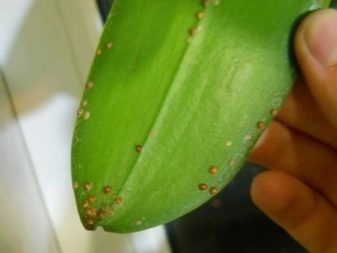

Transplant and reproduction
The tiger orchid, like other plants, needs to be transplanted from time to time. The flower grows, it becomes cramped in the same container. With this procedure, you need to act very carefully. If something goes wrong, the moody orchid may not take root in the new pot. Therefore, you must follow all the rules.
By the time of transplanting, the orchid should be blooming. The new plastic transparent pot should be larger than the previous one. The plant is watered very well at first. This will make it easier to remove from the pot. Then all the earth is removed from the roots, washed in warm water and left for half an hour to dry. After that, the roots are carefully examined.
If there are rotten scions, they are carefully trimmed with scissors.

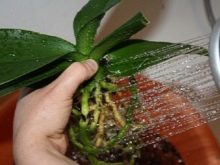

Places of cuts are treated with activated carbon powder. The roots are carefully placed in a container, the prepared soil is gradually poured from all the necessary components (moss, bark, fern roots, charcoal, sand, peat, walnut shells). Then the flower is strengthened in a pot and watered well.

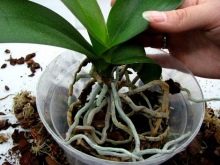

If the orchid is kept in humid and warm conditions, it often releases so-called babies. They appear on the stem. You need to wait until they have roots.
Then they can be separated and planted in separate pots, preparing the correct substrate, as with transplanting.
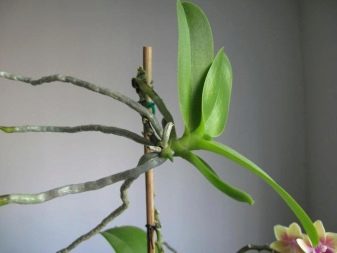

Another breeding method is to trim the stem after flowering. Places of cuts must be treated with charcoal. Then the cuttings should be placed in moss, and covered with glass or transparent film on top so that a sufficiently high temperature and humid environment are observed. From time to time, the glass needs to be opened, and the moss should be moistened.... When the roots appear, you can plant the cuttings in pots.
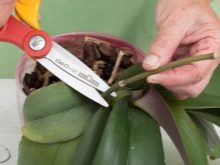
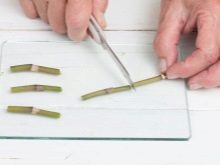
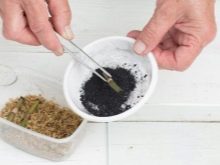
Another method is applicable when transplanting an adult plant. The orchid is carefully removed from the pot after pre-watering.Then it is washed, the roots are dried. You can carefully divide the bush into two or three parts, depending on its size, the number of roots and leaves. Then the resulting plants are transplanted into prepared containers and covered with a substrate.
The following video tells about proper orchid care.































The comment was sent successfully.